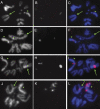Translocation of Y-linked genes to the dot chromosome in Drosophila pseudoobscura
- PMID: 20147437
- PMCID: PMC2912472
- DOI: 10.1093/molbev/msq045
Translocation of Y-linked genes to the dot chromosome in Drosophila pseudoobscura
Abstract
One of the most striking cases of sex chromosome reorganization in Drosophila occurred in the lineage ancestral to Drosophila pseudoobscura, where there was a translocation of Y-linked genes to an autosome. These genes went from being present only in males, never recombining, and having an effective population size of 0.5N to a state of autosomal linkage, where they are passed through both sexes, may recombine, and their effective population size has quadrupled. These genes appear to be functional, and they underwent a drastic reduction in intron size after the translocation. A Y-autosome translocation may pose problems in meiosis if the rDNA locus responsible for X-Y pairing had also moved to an autosome. In this study, we demonstrate that the Y-autosome translocation moved Y-linked genes onto the dot chromosome, a small, mainly heterochromatic autosome with some sex chromosome-like properties. The rDNA repeats occur exclusively on the X chromosome in D. pseudoobscura, but we found that the new Y chromosome of this species harbors four clusters bearing only the intergenic spacer region (IGS) of the rDNA repeats. This arrangement appears analogous to the situation in Drosophila simulans, where X-rDNA to Y-IGS pairing could be responsible for X-Y chromosome pairing. We postulate that the nascent D. pseudoobscura Y chromosome acquired and amplified copies of the IGS, suggesting a potential mechanism for X-Y pairing in D. pseudoobscura.
Figures






Similar articles
-
An investigation of Y chromosome incorporations in 400 species of Drosophila and related genera.PLoS Genet. 2018 Nov 2;14(11):e1007770. doi: 10.1371/journal.pgen.1007770. eCollection 2018 Nov. PLoS Genet. 2018. PMID: 30388103 Free PMC article.
-
Y chromosome of D. pseudoobscura is not homologous to the ancestral Drosophila Y.Science. 2005 Jan 7;307(5706):108-10. doi: 10.1126/science.1101675. Epub 2004 Nov 4. Science. 2005. PMID: 15528405
-
Male sterility and meiotic drive associated with sex chromosome rearrangements in Drosophila. Role of X-Y pairing.Genetics. 1998 May;149(1):143-55. doi: 10.1093/genetics/149.1.143. Genetics. 1998. PMID: 9584092 Free PMC article.
-
The license to pair: identification of meiotic pairing sites in Drosophila.Chromosoma. 1996 Sep;105(3):135-41. doi: 10.1007/BF02509494. Chromosoma. 1996. PMID: 8781181 Review.
-
On the roles of heterochromatin and euchromatin in meiosis in drosophila: mapping chromosomal pairing sites and testing candidate mutations for effects on X-Y nondisjunction and meiotic drive in male meiosis.Genetica. 2000;109(1-2):77-93. doi: 10.1023/a:1026536200594. Genetica. 2000. PMID: 11293799 Review.
Cited by
-
An investigation of Y chromosome incorporations in 400 species of Drosophila and related genera.PLoS Genet. 2018 Nov 2;14(11):e1007770. doi: 10.1371/journal.pgen.1007770. eCollection 2018 Nov. PLoS Genet. 2018. PMID: 30388103 Free PMC article.
-
Development and evolution of Drosophila chromatin landscape in a 3D genome context.Nat Commun. 2024 Nov 1;15(1):9452. doi: 10.1038/s41467-024-53892-0. Nat Commun. 2024. PMID: 39487148 Free PMC article.
-
Genomic changes following the reversal of a Y chromosome to an autosome in Drosophila pseudoobscura.Evolution. 2017 May;71(5):1285-1296. doi: 10.1111/evo.13229. Epub 2017 Apr 10. Evolution. 2017. PMID: 28322435 Free PMC article.
-
Recent selection on the Y-to-dot translocation in Drosophila pseudoobscura.Mol Biol Evol. 2014 Apr;31(4):846-56. doi: 10.1093/molbev/msu002. Epub 2014 Jan 3. Mol Biol Evol. 2014. PMID: 24390701 Free PMC article.
-
The organization and evolution of the Responder satellite in species of the Drosophila melanogaster group: dynamic evolution of a target of meiotic drive.BMC Evol Biol. 2014 Nov 25;14:233. doi: 10.1186/s12862-014-0233-9. BMC Evol Biol. 2014. PMID: 25424548 Free PMC article.
References
-
- Ashburner M. Drosophila. a laboratory handbook. Cold Spring Harbor (NY): Cold Spring Harbor Laboratory Press; 1989.
-
- Ault JG, Rieder CL. Meiosis in Drosophila males. I. The question of separate conjunctive mechanisms for the XY and autosomal bivalents. Chromosoma. 1994;103:352–356. - PubMed
-
- Brianti MT, Ananina G, Recco-Pimentel SM, Klaczko LB. Comparative analysis of the chromosomal positions of rDNA genes in species of the tripunctata radiation of Drosophila. Cytogenet Genome Res. 2009;125:149–157. - PubMed
-
- Bridges CB. The mutants and linkage data of chromosome four of Drosophila melanogaster. Biol Zh. 1935;4:401–420.
-
- Carvalho AB, Clark AG. Y chromosome of D. pseudoobscura is not homologous to the ancestral Drosophila Y. Science. 2005;307:108–110. - PubMed
Publication types
MeSH terms
Substances
Grants and funding
LinkOut - more resources
Full Text Sources
Molecular Biology Databases

